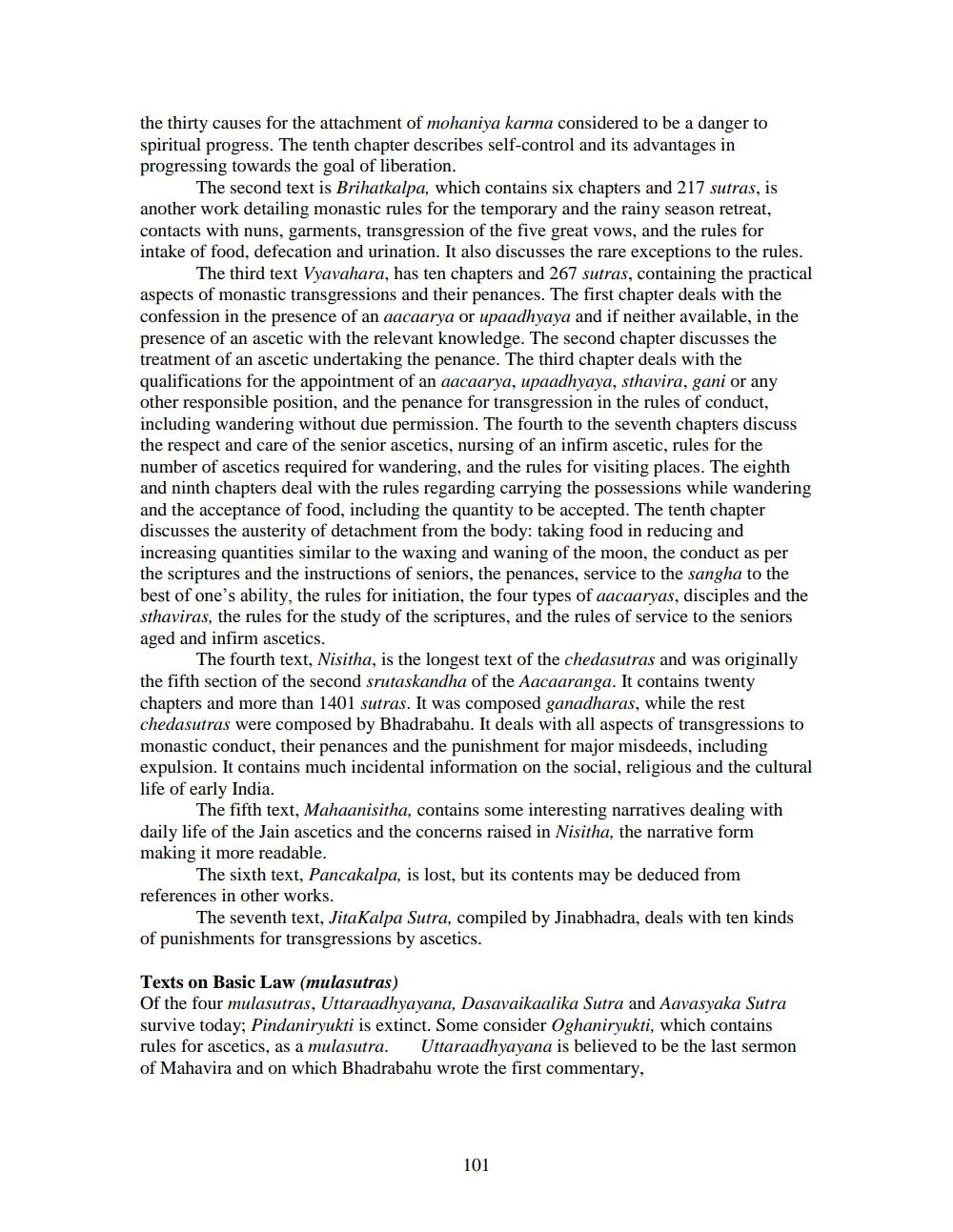________________
the thirty causes for the attachment of mohaniya karma considered to be a danger to spiritual progress. The tenth chapter describes self-control and its advantages in progressing towards the goal of liberation.
The second text is Brihatkalpa, which contains six chapters and 217 sutras, is another work detailing monastic rules for the temporary and the rainy season retreat, contacts with nuns, garments, transgression of the five great vows, and the rules for intake of food, defecation and urination. It also discusses the rare exceptions to the rules.
The third text Vyavahara, has ten chapters and 267 sutras, containing the practical aspects of monastic transgressions and their penances. The first chapter deals with the confession in the presence of an aacaarya or upaadhyaya and if neither available, in the presence of an ascetic with the relevant knowledge. The second chapter discusses the treatment of an ascetic undertaking the penance. The third chapter deals with the qualifications for the appointment of an aacaarya, upaadhyaya, sthavira, gani or any other responsible position, and the penance for transgression in the rules of conduct, including wandering without due permission. The fourth to the seventh chapters discuss the respect and care of the senior ascetics, nursing of an infirm ascetic, rules for the number of ascetics required for wandering, and the rules for visiting places. The eighth and ninth chapters deal with the rules regarding carrying the possessions while wandering and the acceptance of food, including the quantity to be accepted. The tenth chapter discusses the austerity of detachment from the body: taking food in reducing and increasing quantities similar to the waxing and waning of the moon, the conduct as per the scriptures and the instructions of seniors, the penances, service to the sangha to the best of one's ability, the rules for initiation, the four types of aacaaryas, disciples and the sthaviras, the rules for the study of the scriptures, and the rules of service to the seniors aged and infirm ascetics.
The fourth text, Nisitha, is the longest text of the chedasutras and was originally the fifth section of the second srutaskandha of the Aacaaranga. It contains twenty chapters and more than 1401 sutras. It was composed ganadharas, while the rest chedasutras were composed by Bhadrabahu. It deals with all aspects of transgressions to monastic conduct, their penances and the punishment for major misdeeds, including expulsion. It contains much incidental information on the social, religious and the cultural life of early India.
The fifth text, Mahaanisitha, contains some interesting narratives dealing with daily life of the Jain ascetics and the concerns raised in Nisitha, the narrative form making it more readable.
The sixth text, Pancakalpa, is lost, but its contents may be deduced from references in other works.
The seventh text, Jita Kalpa Sutra, compiled by Jinabhadra, deals with ten kinds of punishments for transgressions by ascetics.
Texts on Basic Law (mulasutras) Of the four mulasutras, Uttaraadhyayana, Dasavaikaalika Sutra and Aavasyaka Sutra survive today; Pindaniryukti is extinct. Some consider Oghaniryukti, which contains rules for ascetics, as a mulasutra. Uttaraadhyayana is believed to be the last sermon of Mahavira and on which Bhadrabahu wrote the first commentary,
101




